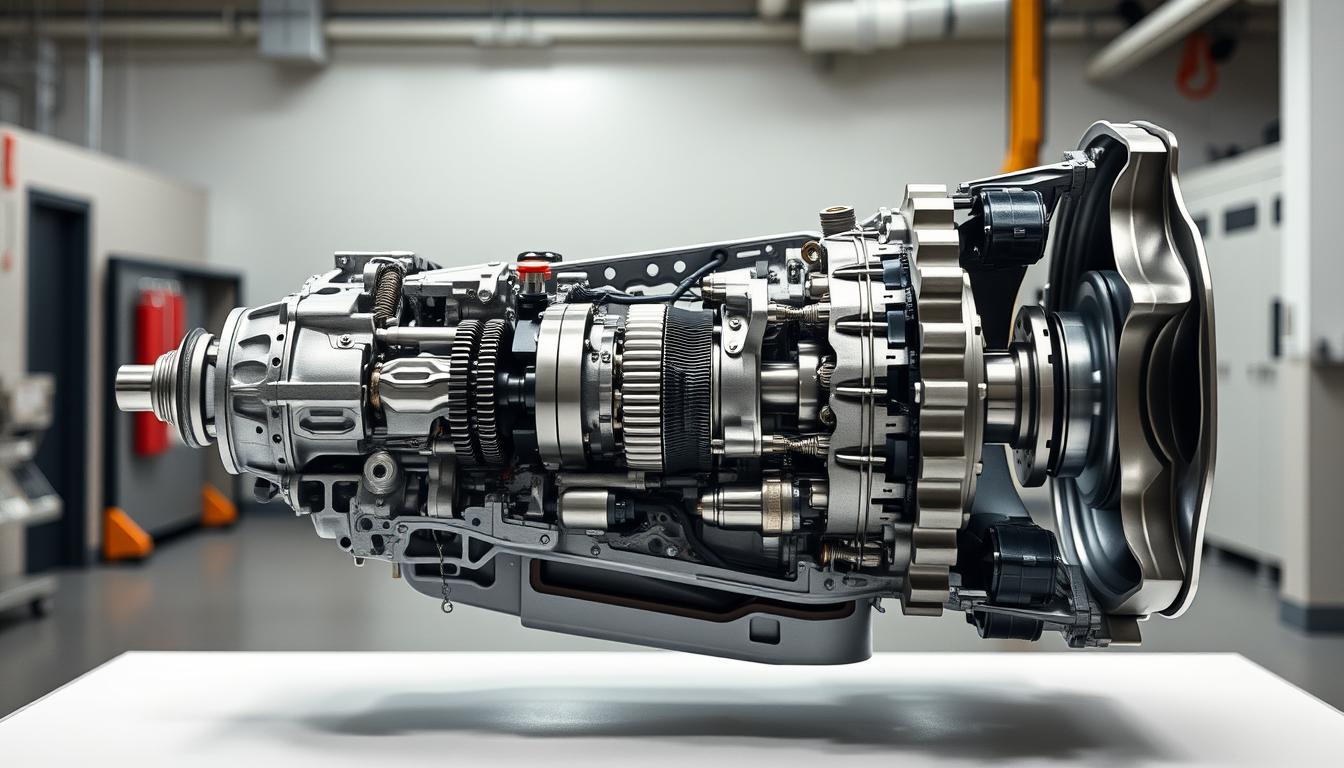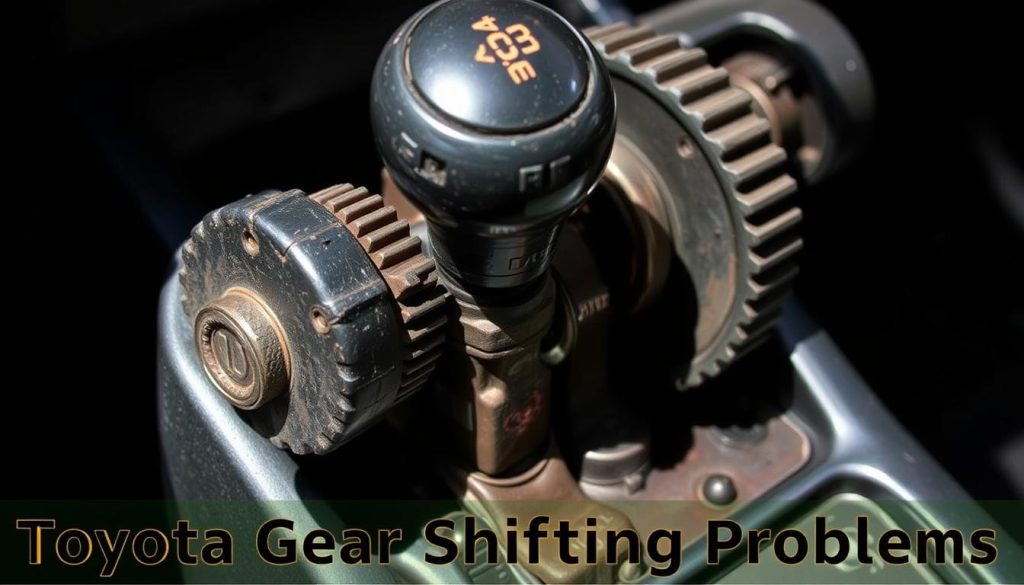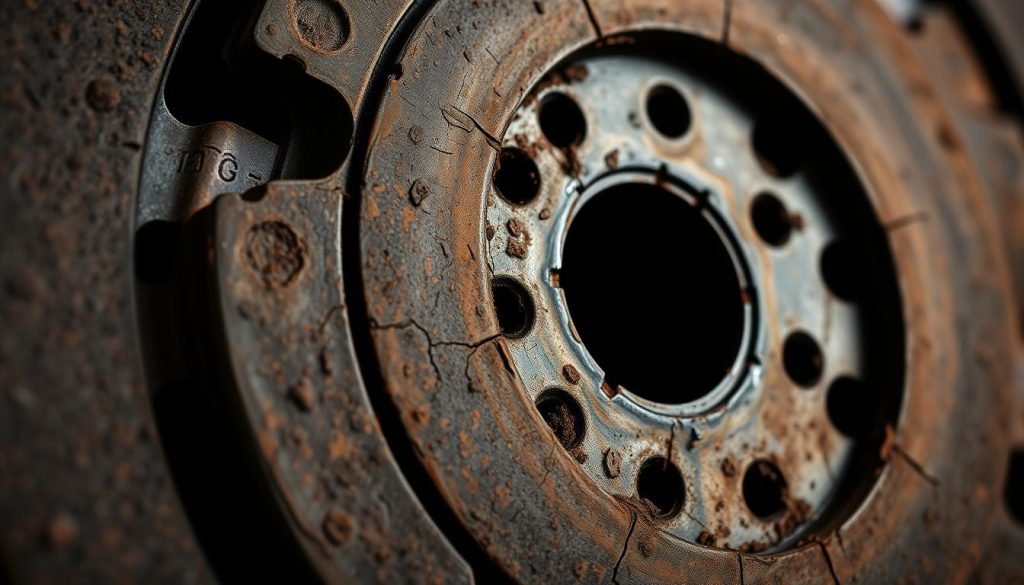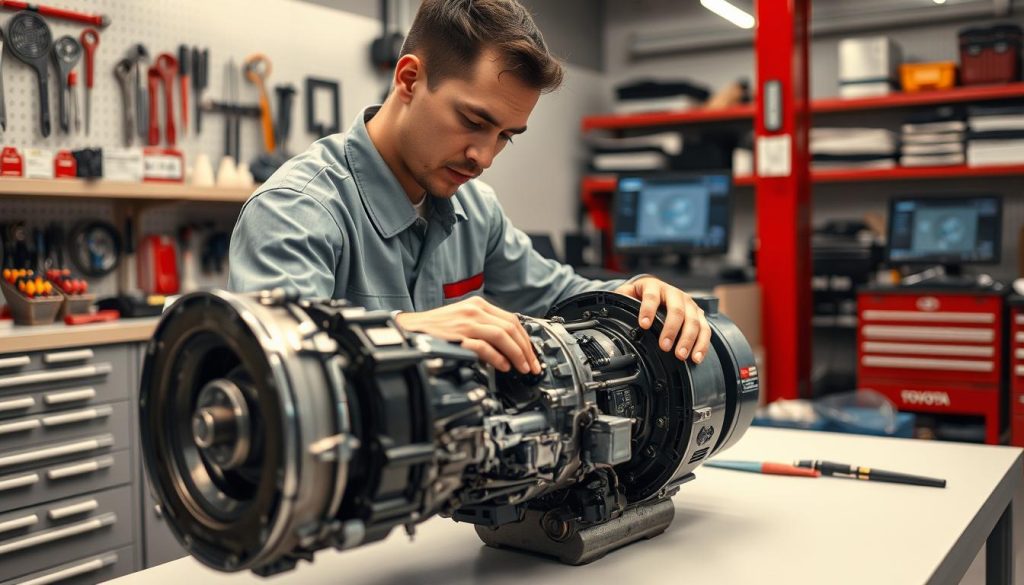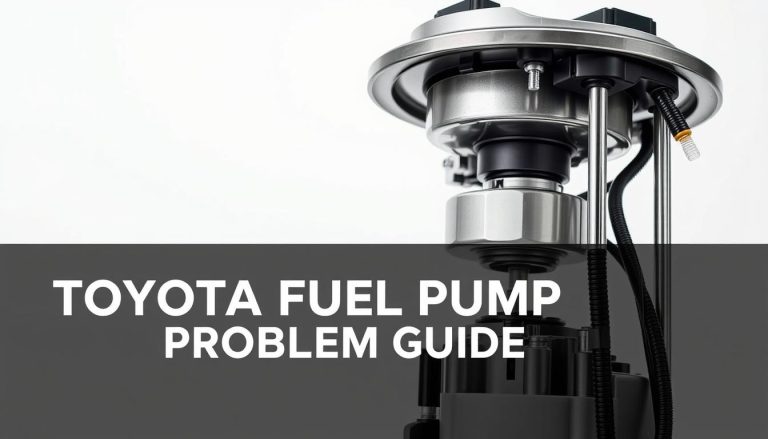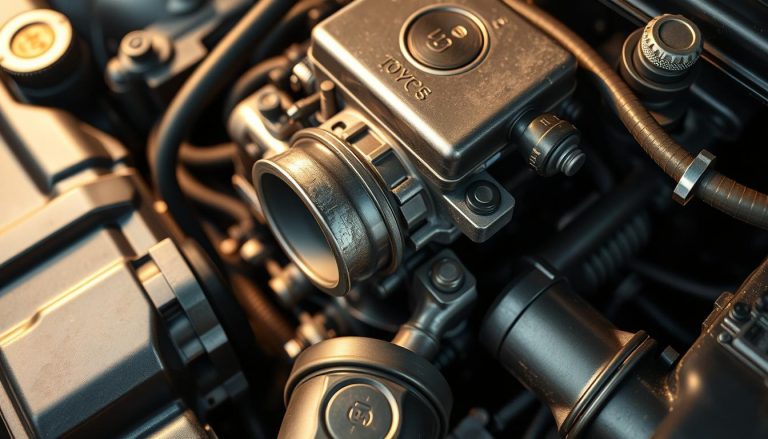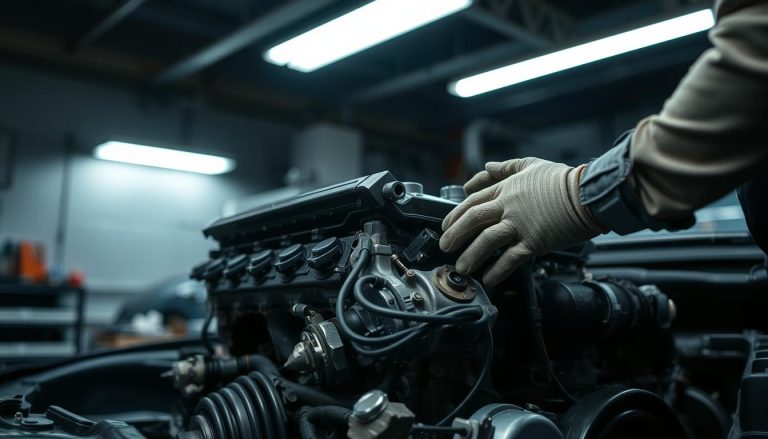Toyota Hard Shifting: Causes & Solutions
Toyota’s sleek design can turn into a jerky ride if it has hard shifting problems. This issue affects both manual and automatic transmissions, worrying many car owners. It’s important to fix these problems quickly to keep your car running well and make driving comfortable again.
Knowing what causes hard shifting and how to fix it can help. This guide will help you understand and solve Toyota’s transmission issues. It will also show you how to keep your car running smoothly.
This guide will cover diagnosing symptoms and prevention tips. We’ll explore what makes shifting hard and how to fix it. Let’s get into the details.
Understanding Toyota Hard Shifting
Hard shifting means your car’s gears change in a rough way. This can be a big problem in Toyotas, leading to issues with the automatic transmission. Knowing what hard shifting is and spotting its signs early can help avoid expensive repairs.
What Is Hard Shifting?
Hard shifting is when your car’s gears change in a jarring way. You might feel a sudden jerk or hear the engine noise get louder. It shows the transmission is having trouble shifting gears, which could mean there’s a bigger problem.
Common Symptoms
Spotting the signs of hard shifting early is key. Look out for:
- Difficulty in changing gears
- Unusual noises during gear shifts
- Vehicle hesitating or surging
If you notice these signs, it’s time to get a professional to check it out. Ignoring them can hurt your car’s performance and might even cause damage to the transmission, leading to costly repairs.
How Your Toyota Transmission Works
Your Toyota transmission is key to your car’s performance. It turns engine power into smooth motion. Knowing how it works helps with keeping it in good shape and fixing any issues.
Mechanics of Automatic Transmission
Toyota’s automatic transmissions use a planetary gear system. This system makes shifting gears smooth and quick. It has clutches and bands that help with gear changes.
Regular maintenance keeps these parts working well. This prevents problems that come with wear and tear.
Manual Transmission Operation
Manual transmissions use a clutch pedal and a gear lever. The clutch lets you shift gears by disconnecting the engine from the transmission. Toyota manual transmissions have five to six gears.
This lets drivers control the engine’s power and speed. Regular checks and replacements of the clutch ensure smooth shifting and a long-lasting transmission.
Understanding your transmission’s mechanics and the need for regular maintenance is key. This way, you can avoid problems and enjoy a smooth ride.
Signs Your Toyota Transmission Is In Trouble
Knowing the signs of a troubled Toyota transmission is key. A common issue is when the gear shift feels rough. This can make driving uncomfortable. Also, listen for grinding or buzzing sounds when shifting gears.
A burning smell from your car is another warning sign. This smell usually means the transmission fluid is overheating. If your car hesitates to move after shifting gears, it’s a sign of trouble too. This could mean it’s time for a Toyota transmission check-up.
Seeing transmission fluid leaks is a clear warning. This fluid is usually bright red but can darken over time. Check for fluid leaks under your car when it’s parked. Catching these signs early and getting a Toyota transmission check can prevent bigger problems. It can also save you from expensive repairs.
Common Reasons for Toyota Gear Shifting Problems
Having trouble with your Toyota’s gear shifting can be annoying and even dangerous. Knowing why these problems happen can help you fix them quickly. Here are some common reasons for Toyota gear shifting issues.
Fluid Leak
A leak in the transmission fluid is a big reason for hard shifting in Toyotas. This fluid keeps the transmission parts moving smoothly. Without enough fluid, the gears can overheat and shift poorly.
Solenoid Failure
The solenoids in your Toyota’s transmission control the fluid flow. If they fail, the fluid pressure and timing get messed up. This usually means you need a pro for the repair.
Transmission Fluid Contamination
Dirty transmission fluid can make shifting hard. It happens when the fluid gets old or when the wrong type is used. Keeping the fluid clean is key to avoiding this.
Transmission Failure
When the transmission fails, shifting becomes a big problem. This can be due to worn-out gears or other internal issues. It might need a lot of repair or even a new transmission.
Faulty Shifter Cable
The shifter cable connects the gear shifter to the transmission. If it’s damaged, it can show the wrong gear. Catching this early is important for smooth shifting.
Clutch Wear
In manual Toyotas, a worn-out clutch can cause shifting issues. A bad clutch disc or pressure plate stops gears from engaging right. Fixing it quickly helps avoid more damage.
Fluid Leak: What to Watch For
Keeping an eye out for fluid leaks is key in Toyota transmission care. A leak can lead to hard shifting and bigger problems if not fixed. Knowing how to spot and stop leaks is vital for your car’s smooth running.
Identifying a Transmission Fluid Leak
Leaks show up as bright pink or red fluid under your car. It might turn brown over time, meaning it’s time for a check. Regular checks can catch leaks early and avoid bigger issues. Look for puddles in your parking spot, after your car has been parked for a while.
How to Prevent Fluid Leaks
Stopping leaks starts with regular Toyota transmission care. First, check the fluid level and look for signs of contamination or wear. Replace the fluid as your owner’s manual suggests. Also, use top-notch seals and the right transmission fluids to cut down on leaks and hard shifting.
| Steps | Description |
|---|---|
| Regular Inspection | Check fluid levels and watch for any signs of leaks or fluid discoloration. |
| Timely Replacement | Follow the manufacturer’s schedule for fluid replacement to keep the transmission functioning optimally. |
| High-Quality Seals | Use recommended seals and gaskets to maintain a tight seal and prevent leaks. |
| Appropriate Fluids | Choose the correct type of transmission fluid for your specific Toyota model. |
Solenoid Failure: Causes and Fixes
Solenoids are key in your Toyota’s transmission system. They control the flow of transmission fluid for smooth gear shifts. If they fail, you might see erratic or improper shifting.
Role of Solenoids in Transmission
A solenoid in your Toyota’s transmission system is like an electromechanical valve. It opens and closes to manage hydraulic fluid for gear shifts. Working solenoids help gear shifts happen on time and smoothly.
Diagnosing Solenoid Issues
Figuring out solenoid problems in Toyotas often involves electrical tests and pressure checks. Technicians first look for fault codes with diagnostic tools. Then, they check the electrical circuits and solenoid pressure to find the problem.
Repairing or Replacing Solenoids
To fix solenoid failure, the best option is Toyota transmission repair. This usually means replacing bad solenoids with OEM parts. This ensures they fit right and last long. It also gets your vehicle’s transmission working its best.
Importance of Transmission Fluid Maintenance
Keeping your Toyota’s transmission fluid in good shape is key. It stops hard shifting and makes gear changes smooth. The fluid breaks down over time due to heat and wear. So, it needs to be replaced regularly to keep your car running well.
When to Replace Transmission Fluid
Toyota manuals say to change the fluid every 60,000 to 100,000 miles. It’s important to check and replace it on time. This helps avoid hard shifting and other problems with the transmission.
Steps for a Transmission Fluid Flush
- First, lift the car and drain the old fluid completely.
- Then, clean the transmission system to get rid of dirt and debris.
- Lastly, fill it up with high-quality Toyota-approved fluid for better performance.
Regular maintenance of your Toyota’s transmission fluid is essential. It not only extends your car’s life but also prevents issues like hard shifting and breakdowns.
Dealing with Transmission Failure in Your Toyota
Transmission failure in your Toyota can be scary, but spotting early signs can help. It’s important to notice any changes in how your car runs. This way, you can act fast to avoid bigger problems.
Early Warning Signs
Spotting a Toyota transmission failure early can save you money and time. Look out for these signs:
- Unusual noises such as whining or clunking
- Delayed or rough shifting
- Burning smell from the transmission fluid
- Noticeable fluid leaks under the car
- Warning light on the dashboard
Options for Transmission Repair or Replacement
If your Toyota’s transmission fails, you have two choices: fix it or replace it. Decide based on the damage and your car’s age and mileage.
For small problems, fixing parts like gears and clutches might work. But if the damage is big, replacing the whole transmission could be better. It might cost more upfront but last longer.
| Repair Option | Pros | Cons |
|---|---|---|
| Repair | Lower immediate cost, fixes specific problems | Potential for recurring issues, shorter lifespan |
| Replacement | Long-term reliability, addresses all issues | Higher upfront cost, more labor-intensive |
Choosing wisely between repair or replacement can keep your Toyota running well for years.
Addressing Faulty Shifter Cables
Toyota owners often face Toyota shifter cable issues. These cables link the transmission to the shifter inside your car. Over time, they can stretch or break, causing Toyota gear shifting problems. This can lead to misaligned gears or trouble shifting.
Checking the shifter cables regularly can spot problems early. Signs of bad cables include a loose shifter, hard gear changes, or gears that don’t line up right. Catching these signs early is key to avoiding bigger issues.
If you see Toyota gear shifting problems, get a mechanic’s help. They can tell if the cables need fixing or replacing. Fixing or swapping out bad cables is important for your Toyota’s smooth shifting and driving.
Fixing Toyota shifter cable issues early keeps your car safe and running well. It gives you peace of mind while driving.
Clutch Wear and Its Impact on Shifting
It’s important to address clutch wear to keep shifting smooth in your Toyota. A good clutch makes the engine and transmission work together well. This helps your car perform at its best. Keeping your clutch in good shape can also prevent hard shifting.
Indicators of a Worn Clutch
Knowing the signs of a worn clutch is key. Look out for these:
- Spongy or bouncy clutch pedal
- Difficulty shifting gears
- Grinding noises when changing gears
- Burning smell during shifts
- Poor acceleration even with increased RPM
These signs mean your clutch might need attention. It’s time to check your Toyota manual transmission.
Maintaining Your Clutch
Regular care can make your clutch last longer. Here are some tips:
- Adjust the clutch pedal for better engagement and disengagement.
- Replace the clutch disc and bearings when needed.
- Don’t ride the clutch by keeping your foot off it when not shifting.
- Have regular checks to spot clutch wear early.
By taking care of your clutch, you’ll enjoy better driving and keep your car’s transmission in top shape. Spotting clutch wear and following maintenance tips can prevent big problems. This way, your car will keep running smoothly.
Toyota Transmission Diagnosis
To keep your Toyota running smoothly, accurate Toyota transmission diagnosis is key. This process helps spot issues early and fixes them quickly. It prevents bigger problems. You can do it yourself or have a pro do it.
Professional Diagnostic Tools
Professionals use advanced tools to check your Toyota’s transmission. An OBD-II scanner connects to your car’s computer. It finds errors like hard shifting and solenoid problems.
DIY Diagnosis Techniques
If you like to fix things yourself, there are ways to check your transmission. First, check the fluid levels and condition. Low or dirty fluid means a leak or contamination, causing hard shifting.
Also, listen for odd engine sounds when shifting gears. Clicks or grinding sounds mean something’s wrong inside. Watch how your Toyota shifts during driving. Slows or jolts can show transmission issues.
The Role of a Toyota Transmission Specialist
Keeping your Toyota’s transmission running smoothly is key. A Toyota transmission specialist is vital for complex issues. They go beyond simple fixes.
When to See a Specialist
Know when to call a Toyota transmission specialist. Look out for warning lights, strange noises, and fluid leaks. These signs mean serious problems are coming.
Finding the Right Technician
- Check Credentials: Look for ASE certification.
- Experience with Toyota Models: They should know Toyota’s systems well.
- Read Reviews: See what others say about their service.
| Factors | Why It Matters |
|---|---|
| Certification | It shows they meet industry standards. |
| Experience | They’re better at fixing Toyota problems. |
| Customer Reviews | They tell you about the service quality. |
Finding a skilled Toyota transmission specialist is worth it. They can prevent future problems and give you peace of mind.
Toyota Transmission Repair vs. Replacement
Choosing between Toyota transmission repair or replacement can be tough. It’s important to consider the costs and how long each option will last.
Cost Considerations
Fixing a Toyota transmission usually costs less than replacing it. Small fixes like leak repairs or worn-out part replacements are cheaper if the transmission is mostly fine. But, if the damage is big or the transmission is old, the price goes up fast, making replacement a better choice.
| Repair Type | Average Cost |
|---|---|
| Minor Repair (Leaks, Solenoid Issues) | $500 – $1,000 |
| Rebuild | $1,500 – $3,000 |
| Full Replacement | $4,000 – $7,000 |
Longevity After Repair
Choosing between repair and replacement also depends on how long your car will last. Small fixes can make your transmission last longer. But, if your car is old or has a lot of miles, a full replacement might be better.
Both options have their good points. But, talking to a certified Toyota transmission expert can help you decide what’s best for your car.
Preventing Future Transmission Issues
Proper care and maintenance of your Toyota transmission can extend its lifespan and performance. Let’s explore essential maintenance tips and driving habits to avoid transmission issues.
Regular Maintenance Tips
Routine Toyota transmission maintenance is key. Here’s a checklist to help you:
- Regularly check and change the transmission fluid. Use the correct type noted in the owner’s manual.
- Schedule periodic transmission inspections with a qualified technician to catch issues early.
- Ensure timely replacement of the transmission filter to keep the fluid clean.
- Monitor and address any signs of fluid leaks immediately to avoid further damage.
Driving Habits to Avoid
Adopt gentle and mindful driving habits to prevent wear and tear on your transmission. Here are some practices to avoid:
- Avoid towing loads that exceed your vehicle’s capacity. Overloading strains your transmission.
- Avoid rapid acceleration and hard braking, which stress the gear system.
- Do not frequently shift gears while the vehicle is in motion; always bring your car to a complete stop before changing gears.
- Refrain from driving aggressively; a smoother driving style promotes a smoother gear shift, minimizing the risk of Toyota gear shift not smooth.
By following these Toyota transmission maintenance tips and driving habits, you can ensure your transmission stays in top condition. This helps avoid the Toyota gear shift not smooth issue.
Customer Stories: Overcoming Toyota Transmission Troubles
Many Toyota owners have faced Toyota transmission issues. Their stories show resilience and effective solutions. Kevin from Ohio had a 2018 Toyota Camry with hard shifting. He noticed jolts and trouble shifting gears.
Kevin talked to a local Toyota specialist. They found a faulty solenoid. Replacing it fixed the problem, making driving smooth again.
Emily’s RAV4 got stuck in first gear due to a mechanical failure. The fluid was dark and dirty. A mechanic suggested a fluid flush and a new filter.
After the repair, Emily was relieved and happy. She told others to check their transmission fluids regularly to avoid Toyota hard shifting repair stories.
Arthur, a Tacoma driver, had trouble with his vehicle not shifting gears right. A leaky seal had drained most of the fluid. After fixing the seal and refilling the fluid, Arthur’s shifting improved.
Arthur advised Toyota owners to watch for fluid leaks. These stories show that fixing problems like solenoid replacements or fluid flushes can solve big issues. Regular checks and care can prevent many problems.
Toyota Automatic Transmission Trouble: Specific Issues
Toyota automatic transmission trouble can come from many specific issues. These problems can really affect how well your car runs. Spotting these issues early and knowing how to fix them can help avoid expensive repair costs.
Common Problems in Automatic Models
Toyota automatic model owners often face issues like delayed gear changes, shifting without reason, and unexpected slips. These signs can be scary and usually mean there’s a bigger problem with the transmission. Problems like failing solenoids, wrong fluid levels, and old software can cause these issues.
Addressing Automatic Transmission Issues
Fixing Toyota automatic transmission trouble needs a few steps. Here’s what you can do:
- Recalibration of the Transmission Module: This adjusts the transmission settings for better performance.
- Solenoid Repair: Bad solenoids can mess up fluid flow, leading to shifting problems.
- Firmware Updates: Keeping the transmission firmware current can fix many software issues.
While some car owners can handle simple maintenance, complex repairs should be done by a pro. A professional can find and fix the real problems, avoiding more damage to the transmission.
Safety Concerns Related to Hard Shifting
Toyota hard shifting is more than just a hassle; it’s a serious safety risk. When shifting is harsh or delayed, it can make your car act unpredictably. This is very dangerous when you’re merging or stopping suddenly.
Hard shifting can cause your car to jerk or stall suddenly. This can lead to losing control, which is risky, not just for you but for others on the road too. It’s important to check your transmission regularly and fix any issues right away to stay safe.
Don’t ignore the signs of hard shifting. If you do, it could lead to bigger problems, more expensive repairs, and even a broken transmission. Fixing hard shifting issues quickly keeps your car running smoothly. It also makes the roads safer for everyone.
Tips for Maintaining a Smooth Gear Shift
Keeping your Toyota’s gear shifts smooth requires regular care and smart driving. By following these tips, you can make your car’s transmission last longer. This means smoother gear changes and a better driving experience.
Importance of Regular Check-Ups
Regular visits to a Toyota gear shift maintenance expert are key. A certified Toyota technician can spot and fix problems early. They check the transmission fluid, shifter alignment, and overall condition during these visits.
This ensures your car shifts smoothly without any issues.
How to Drive for Optimal Gear Performance
Smart driving habits also help with Toyota smooth shifting. Avoid sudden starts and harsh driving. Instead, use gentle acceleration and change gears smoothly in manual transmissions.
This reduces wear on the gears and helps your transmission last longer.
Conclusion
Understanding Toyota transmission systems is key to keeping your car running well. Knowing why your car shifts hard is important. Regular checks and fixes can prevent big problems.
Getting help from experts and fixing issues early can make driving smooth. Whether it’s fixing the transmission or driving carefully, knowing what to do helps. This way, you can avoid costly repairs and enjoy driving more.
Knowing how to fix hard shifting makes you a better car owner. Taking care of your transmission means your car lasts longer. It also means you can enjoy driving without worrying about sudden repairs.
FAQ
What Is Hard Shifting?
Hard shifting is when changing gears feels rough and uncomfortable. It might make the engine sound louder and feel like it jerks.
What are Common Symptoms of Hard Shifting in Toyota Vehicles?
Signs include trouble shifting gears, odd noises when shifting, and the car hesitating or surging.
How Does Automatic Transmission in a Toyota Work?
Toyota’s automatic transmissions use a complex system for smooth gear changes. This system is called the planetary gear system.
What Should I Watch for to Identify Toyota Transmission Issues?
Look out for grinding or buzzing sounds, a burning smell, and if the car hesitates after shifting. Also, check for any fluid leaks.
What Are Some Common Reasons for Toyota Gear Shifting Problems?
Problems can stem from fluid leaks, solenoid failure, dirty transmission fluid, or mechanical issues. These include worn-out clutches or broken shifter cables.
How Can I Identify a Transmission Fluid Leak in My Toyota?
Look for bright pink or red fluid under your car. It might turn brown over time.
How Can I Prevent Transmission Fluid Leaks?
Prevent leaks by regularly checking and maintaining the fluid level. Also, replace the fluid on time and use high-quality seals and fluids.
What is the Role of Solenoids in Transmission?
Solenoids help control the flow of transmission fluid. This makes gear shifts smooth.
How Do I Diagnose Solenoid Issues in My Toyota?
To diagnose solenoid problems, do electrical tests and pressure measurements. Symptoms include shifting issues.
When Should I Replace My Toyota’s Transmission Fluid?
Toyota manuals suggest replacing transmission fluid every 60,000 to 100,000 miles.
What Are the Early Warning Signs of Transmission Failure?
Early signs include persistent noises, fluid leaks, and shifting problems.
How Do I Address Faulty Shifter Cables in My Toyota?
If your shifter cables are faulty, you might need to adjust or replace them. This will help restore proper transmission function.
What are the Indicators of a Worn Clutch?
Signs include a spongy or bouncy clutch pedal and a burning smell during shifts.
How Can I Maintain My Toyota’s Clutch?
Keep your clutch in good shape by regularly inspecting and maintaining it. Adjust the clutch pedal and replace the clutch disc and bearings as needed.
What Tools are Used for Professional Transmission Diagnosis?
Professionals use advanced tools like OBD-II scanners for accurate diagnosis.
When Should I See a Toyota Transmission Specialist?
See a specialist for complex transmission problems that are beyond DIY repairs.
How Do I Find the Right Technician for My Toyota Transmission?
Look for a technician with Toyota experience and good reviews. This ensures you get reliable service.
What Should I Consider When Choosing Between Transmission Repair and Replacement?
Consider the cost and how long the repair will last. Repairs are cheaper but might not last long if the damage is severe.
What Maintenance Tips Help Prevent Future Transmission Issues?
Regular fluid changes and using the right fluid are key. Avoid harsh driving habits like towing over capacity to prevent wear.
What are Common Problems in Toyota Automatic Models?
Issues include delayed gear engagement or shifting without control. These problems often need solenoid repair or firmware updates.
How Can I Maintain a Smooth Gear Shift in My Toyota?
For smooth shifting, get regular transmission checks and drive carefully. Avoid sudden starts to reduce wear.

